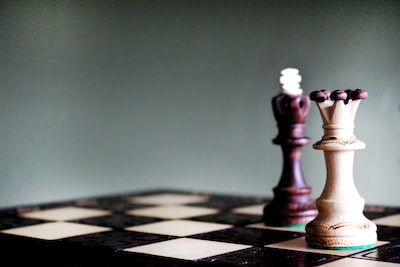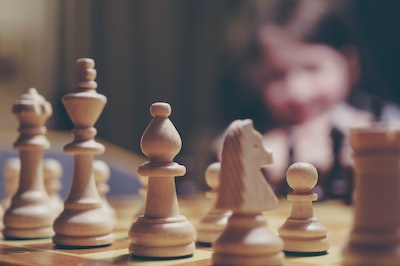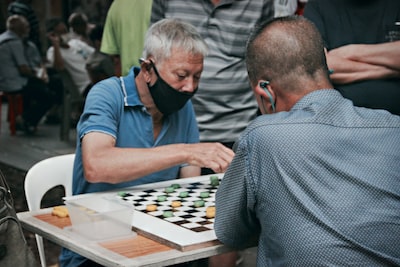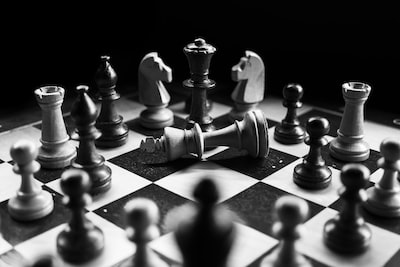Tactics vs. Strategy in Chess: Do You Know the Difference?
In the realm of chess, where each move holds the power to make or break a game understanding the line, between tactics and strategy is key. Many players often mix up these concepts missing the distinctions that define them.
Tactics involve the moves and sequences used by players to achieve short-term goals while strategy encompasses the plan that directs these moves towards long-term objectives. Essentially tactics represent skirmishes on the chessboard while strategy embodies the overarching battle that shapes the outcome.
So are you familiar, with how tactics and strategy differ in chess? Let's delve into it.
1. Introduction to chess tactics and strategy
In the game of chess tactics refer to moves that aim for advantages such, as capturing a piece or achieving checkmate. These tactical actions involve thinking, precise execution, and anticipation of moves. On the other hand strategy in chess revolves around long-range planning. Establishing objectives. Strategic thinking entails analyzing the board position assessing pawn structures influencing squares and anticipating the adversary strategies. While tactics secure victories, on the chessboard it is planning that ultimately leads to winning the overall battle by harmonizing various tactical maneuvers towards a common objective.

Successful players balance using tactics to gain advantages and using strategy to turn those advantages into victory. Understanding tactics versus strategy in chess can improve decision-making, predict opponents' moves, and lead to success on the board.
2. The importance of tactics in chess
Chess.com, a platform, for chess lovers highlights the importance of strategy in winning matches. The strategy involves calculations. Recognizing opportunities to gain an advantage or pose threats. By honing their abilities players can edge ahead. Improve their chances of victory on the board. Understanding concepts like traps, double attacks, and pins can provide benefits and help players shift the momentum of a game in their favor.
In the realm of chess, strategy plays a role in shaping gameplay and determining its result. Mastering moves effectively can lead to material gains opportunities for checkmate and ultimately triumph on the board. Cultivating an eye for strategy demands practice, perseverance, and a profound grasp of ideas and patterns. Chess.com, a platform for chess learning and practice provides educational resources to assist players in enhancing their strategic abilities and refining their play style. By solving puzzles studying games played by grandmasters and implementing principles in their own matches players can boost their critical thinking skills and tactical awareness. Integrating thinking into their game plan can empower players to unlock their potential and achieve success, in chess matches by making strategy an essential element of mastering chess.
Chess.com offers tips and advice to assist players in mastering the intricacies of chess tactics and improving their gameplay on the board.
3. Understanding chess strategy and its role
Achieving a healthy weight is crucial for your health. It lowers the risk of chronic diseases like heart disease, diabetes, and some cancers. Eating well and staying active are essential to reaching and keeping a healthy weight. Before changing your diet or exercise routine, talk to a healthcare provider. Set achievable goals and monitor your progress to stay motivated. Everyone's path to a healthy weight is different, so find what works for you.

4. Examples of tactical chess moves
Chess players must recognize tactical opportunities to enhance their gameplay. This skill involves assessing the board, finding weaknesses in the opponent's position, and using calculated moves. Spotting tactics not only improves a player's offense but also strengthens defense. Practice, studying patterns, and analyzing games can sharpen tactical vision for success in chess.
5. Developing strategic thinking patterns
Players need to consider factors like pawn structure, piece activity, and king safety when developing effective strategies. By analyzing the board dynamics and predicting outcomes, chess enthusiasts can create a solid plan to outmaneuver their opponents. Developing strategic thinking not only improves gameplay but also boosts mental agility and problem-solving skills.

Successfully using strategic thinking in chess requires patience, foresight, and adaptability. Players must adjust their strategies based on the changing board positions while staying focused on their goals. Being flexible and adapting plans as the game unfolds allows individuals to seize opportunities and overcome challenges. Strategic thinking helps players navigate complex situations, exploit opponent weaknesses, and maximize their pieces' potential, ultimately leading to victory.
6. How to recognize tactical opportunities
Recognizing tactical opportunities in chess requires a sharp eye for finding weaknesses in the opponent's position. Players need to analyze the board to spot potential tactics like forks, pins, skewers, and discovered attacks. By understanding these tactical strategies, players can take advantage of opportunities to gain an advantage or launch a strong attack. Recognizing tactical opportunities is not only about reacting to the opponent's moves but also creating threats and using them to control the game. It involves calculating and visualizing moves to anticipate their outcomes.

Successful chess players are skilled at identifying and exploiting tactical opportunities to shift the game in their favor. This skill requires a deep understanding of tactics, along with planning and foresight. By improving their ability to spot tactical chances, players can outplay their opponents, create threats, and set up winning moves. To develop this skill, players should practice solving tactical puzzles and study master games to learn different strategies. Recognizing tactical opportunities not only increases a player's chances of winning but also deepens their appreciation for the complexity and beauty of chess as a game of skill and intellect.
7. Balancing tactics and strategy in gameplay
Strategic goals involve winning with surprise tactics. Different tactics include forks, pins, skewers, discovered attacks, and deflections. It is important to learn through puzzles, books, and videos, and to practice regularly to improve skills. Stay aware tactically, be vigilant, spot opportunities, create threats, and gain an advantage.

To master chess, it is essential to combine tactics and strategy and harmonize gameplay. This involves studying tactics, recognizing patterns, anticipating moves, outsmarting opponents, and showcasing skills. Employ tactics to gain material, achieve checkmate, exploit weaknesses, and dominate the game.
8. Utilizing tactics to achieve strategic goals
When playing chess, players need to use both tactics and strategy. Tactics help with immediate threats and advantages, while strategy looks at long-term goals. By balancing tactics and strategy, players can improve decision-making, predict opponents' moves, and adjust to changes in the game. Success in chess comes from combining quick tactics with strategic thinking to outsmart opponents.
9. Key differences between tactics and strategy
Tactics are short-term maneuvers that focus on immediate gains, while strategy involves long-term planning and goal-setting. Tactics involve specific moves to exploit weaknesses, while strategy focuses on broader advantages and overall direction. The main difference lies in scope and timing. Tactics are concrete actions to achieve immediate goals, while strategy considers abstract factors like pawn structure and piece activity. Knowing how to use tactics within a strategic framework is crucial for success in chess.

10. Enhancing your chess skills through practice
One effective technique for improving at chess is regularly solving tactical puzzles. These puzzles help players develop their pattern recognition skills and sharpen their calculation abilities. By practicing tactical puzzles consistently, players can enhance their tactical awareness during actual gameplay. Another beneficial practice is studying master games, as this can provide valuable insights into strategic ideas, positional play, and tactical maneuvers. By analyzing the decisions made by masters, players can learn to implement similar strategies in their own games and develop a deeper understanding of chess principles.

Playing practice games against stronger opponents can also help players improve. Facing tougher competition forces players to adapt and make better decisions under pressure. Analyzing games against stronger opponents can help players identify weaknesses and work on enhancing specific aspects of their gameplay. Additionally, reviewing one's own games, whether wins or losses, is crucial for identifying mistakes, learning from them, and refining strategies. Reflecting on past games helps players recognize patterns, assess decision-making processes, and make adjustments for future improvement.
11. Mastering the art of combining tactics and strategy
Tactics in chess involve short-term moves to gain immediate advantages, like capturing an opponent's piece or setting up a checkmate threat. These maneuvers require quick thinking and a sharp eye for opportunities on the board. Players should recognize patterns like pins, forks, and skewers to exploit their opponent's weaknesses and secure victory.
In contrast, chess strategy focuses on long-term planning and overall positioning to achieve broader goals. Strategic thinking includes assessing the entire board, understanding pawn structures, and maneuvering pieces to control key squares. Players must grasp strategic concepts like king safety, pawn structure, and piece activity to maintain a strong position.
By combining tactical precision with strategic foresight, players can navigate complex positions, anticipate opponent moves, and outmaneuver them. Mastering the interplay between tactics and strategy is crucial for success in chess at all levels.
12. Real-world applications of chess tactics and strategy
Playing chess is not just a fun hobby; it also has numerous benefits for cognitive development. Through playing chess, individuals can enhance their critical thinking skills, strategic planning abilities, and decision-making processes. These skills are transferable to various areas of life, such as business and academics. Chess players are known for their problem-solving prowess, pattern-recognition skills, and mental discipline.

Additionally, playing chess can help individuals develop important personal qualities, such as patience, resilience, and perseverance. These qualities can be essential for personal growth and facing adversity in life. By encountering challenges in the game, players can build resilience that can be applied to real-life situations. Moreover, chess improves focus, concentration, and cognitive skills, which are valuable assets in tasks that require sustained attention and intellectual acuity. Overall, playing chess can have a significant impact on problem-solving, decision-making, and cognitive function in various real-world scenarios.
Frequently Asked Questions
In chess, the difference between strategy and tactics lies in their focus and timeframe. The strategy involves long-term planning to achieve overall objectives, such as controlling key areas of the board or creating weaknesses in the opponent's position. On the other hand, tactics are short-term maneuvers or combinations aimed at achieving immediate gains, like winning material or delivering checkmate[2]. While strategy requires planning, tactics rely on calculation[2]. Despite their distinctions, strategy and tactics are interconnected in chess, with tactics often serving strategic goals and strategies guiding tactical decisions[2].
To summarize:
- Strategy: Long-term planning for achieving overall objectives.
- Tactics: Short-term maneuvers or combinations for immediate gains like material advantage or checkmate.
Chess players use both strategies and tactics to succeed in the game, with strategies guiding the overall plan and tactics executing specific moves to achieve strategic goals[5].
Citations:
[1] https://www.chess.com/forum/view/general/strategy-vs-tactics-is-there-a-difference-indeed
[2] https://chessfox.com/the-difference-between-strategy-and-tactics-in-chess/
[3] https://www.reddit.com/r/chess/comments/adjes5/what_is_the_difference_between_strategy_and/
[4] https://www.chess.com/forum/view/general/whats-the-difference-between-strategy-and-tactics
[5] https://asana.com/resources/strategy-vs-tactics
Understanding the difference between tactics and strategy in chess is crucial for players to excel in the game. In chess, **strategy** refers to the overall plan or idea concerning the position, such as maneuvering based on space advantage, while **tactics** are the specific methods used to achieve short-term gains like material advantage through combinations of moves[1][2][3].
- Strategy- is more long-term and involves plans for non-material gains, focusing on overall positional ideas.
- Tactics-, on the other hand, are short-term and involve forced sequences of moves to achieve immediate objectives, often material gains.
Chess grandmasters use both strategies and tactics to capture their opponent's king. The strategy involves positioning pieces for long-term goals, while tactics involve moving pieces into those positions[4].
In summary, strategy in chess is about the overall plan and positional ideas, while tactics are about specific combinations of moves to achieve immediate gains. Both are essential components of successful gameplay in chess.
Citations:
[1] https://www.chess.com/forum/view/general/strategy-vs-tactics-is-there-a-difference-indeed
[2] https://www.chess.com/forum/view/general/what-is-the-difference-between-strategy-and-tactics
[3] https://chessimprover.com/strategy-or-tactics/
[4] https://asana.com/resources/strategy-vs-tactics
[5] https://www.woodenearth.com/blogs/wooden-blog/chess-tactics-or-strategy
Final Thoughts
As chess players, it is crucial to understand the distinction between tactics and strategy. Tactics are short-term moves aimed at gaining immediate advantages, while strategy involves long-term planning and overall positioning on the board.
A player who only focuses on tactics may win battles but lose the war, while a player who neglects tactics may fall victim to unexpected attacks. It is the delicate balance between the two that separates average players from masters.
In the world of chess, every move is like a piece of a puzzle, with tactics and strategy working in tandem to create a masterpiece on the board. One must be able to recognize when a tactical opportunity arises and seize it with precision, while also maintaining a solid strategic foundation to guide the flow of the game.
From sacrifices to traps to mating patterns, a deep understanding of tactics is essential for success in chess. However, strategy is equally important, as it allows a player to anticipate their opponent's moves, plan ahead, and control the overall direction of the game.
By creating weaknesses in the opponent's position and exploiting them with tactical precision, a strategic player can outmaneuver even the most skilled adversaries. In the end, the key to mastering chess lies in finding the right balance between tactics and strategy.
It is not enough to be able to calculate variations or plan several moves ahead; one must also possess the foresight to understand the bigger picture and adapt their plans accordingly. By honing both their tactical skills and strategic acumen, a player can elevate their game to new heights and achieve greatness on the chessboard.
So, the next time you sit down to play a game of chess, remember the difference between tactics and strategy and use them to your advantage. Your opponents won't know what hit them.




Comments
Post a Comment
Thank you for your valuable views